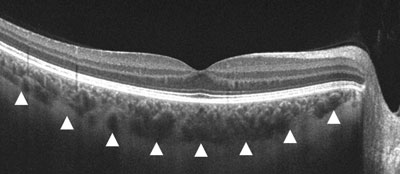 |
|
Choroid thickness may eventually serve as a biomarker for myopia progression with more longitudinal evidence to confirm its predictive ability. Photo: Carolyn E. Majcher, OD. Click image to enlarge. |
A recent study investigated whether choroidal thickness changes could potentially serve as a biomarker for myopia and identify children at greater risk of progression. It found that choroidal thickness is thinnest in the nasal macular region in myopic eyes, and although it’s a possibility, there’s currently insufficient evidence to confirm that this parameter can predict disease progression.
The researchers reviewed data from 250 myopic children aged six to 16 years who were included in the Myopia Outcome Study of Atropine in Children clinical trial. Swept-source OCT was used to obtain images to measure choroidal thickness. The team also explained in their paper that “the macula was divided into nine Early Treatment of Diabetic Retinopathy Study locations with diameters of 1mm, 3mm and 6mm corresponding to the central fovea, parafoveal and perifoveal regions.”
Choroidal thickness varied across the nine macular locations. The researchers reported that the choroid was thickest in the perifoveal superior region (mean: 249µm) and thinnest in the perifoveal nasal region (155µm) for children with low to moderate myopia. In highly myopic children, the choroid was the thickest in the parafoveal temporal region. They added that “on average, choroidal thickness was greater in all parafoveal (232µm) compared with perifoveal (218µm) regions except superiorly where the choroidal thickness was greater in the perifoveal region.”
Several factors were consistently associated with a thinner choroidal thickness in all macular locations, including longer axial length and higher myopic spherical equivalent refraction. Additionally, Asian race was significantly associated with thinner choroidal thickness but only in the parafoveal and perifoveal superior regions.
The team concluded that in the study cohort of children with myopia, “Axial length and spherical equivalent refraction were the key determinants of choroidal thickness, each accounting for approximately 10% of the variance in subfoveal choroidal thickness.” They suggest that “future longitudinal evaluation of the changing profile of choroidal thickness in growing children will be critical to understanding the value of choroidal thickness profile information in informing clinical decision-making.”
Kobia-Acquah E, Flitcroft DI, Lingham G, et al. Choroidal thickness profiles and associated factors in myopic children. Optom Vis Sci. December 2022. [Epub ahead of print]. |

